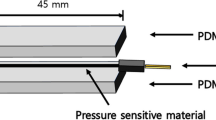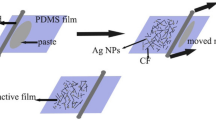Abstract
Flexible strain/pressure sensors play a vital role in flexible wearable electronics. In recent years, carbonized fabric-based flexible strain/pressure sensors are emerging due to their excellent flexibility and sensing performance, as well as facile preparation and low cost. Sensing performance is a key indicator for evaluating strain/pressure sensors. However, the study on the process variables affecting the sensing performance of carbonized fabric-based strain/pressure sensors is lacking to date. In this paper, a flexible pressure sensor based on carbonized fabric/thermoplastic polyurethane was prepared by simple carbonization. By setting different carbonization temperatures (600–1000 °C) and flexible substrate solution concentrations (4–10%), their influence on the sensor sensing performance was explored and a series of characterizations and tests were implemented under different process conditions. The results showed that the carbonization temperature and substrate concentration greatly influence the sensing performance of the sensor. Furthermore, the flexible pressure sensor using carbonized fabric carbonized at 800–900 °C and substrate solution with 6% concentration possesses superior sensing performance.












Similar content being viewed by others
References
S. Chen, S. Liu, P. Wang et al., Highly stretchable fiber-shaped e-textiles for strain/pressure sensing, full-range human motions detection, health monitoring, and 2D force mapping. J. Mater. Sci. 53(4), 2995–3005 (2017)
X. Wang, L. Dong, H. Zhang et al., Recent progress in electronic skin. Adv. Sci. 2(10), 1500169 (2015)
H. Wang, X. Ma, Y. Hao, Electronic devices for human–machine interfaces. Adv. Mater. Interfaces 4(4), 1600709 (2017)
B. Zhou, C. Altamirano, H. Zurian et al., Textile pressure mapping sensor for emotional touch detection in human–robot interaction. Sensors 17(11), 2585 (2017)
M. Amjadi, K.-U. Kyung, I. Park et al., Stretchable, skin-mountable, and wearable strain sensors and their potential applications: a review. Adv. Funct. Mater. 26(11), 1678–1698 (2016)
X.-H. Zhao, S.-N. Ma, H. Long et al., Multifunctional sensor based on porous carbon derived from metal-organic frameworks for real time health monitoring. ACS Appl. Mater. Interfaces. 10(4), 3986–3993 (2018)
M. Amjadi, A. Pichitpajongkit, S. Lee et al., Highly stretchable and sensitive strain sensor based on silver Nanowire-Elastomer nanocomposite. ACS Nano 8(5), 5154–5163 (2014)
S. Gong, D.T.H. Lai, B. Su et al., Highly stretchy black gold E-skin nanopatches as highly sensitive wearable biomedical sensors. Adv. Electron. Mater. 1(4), 1400063 (2015)
Z. Zhan, R. Lin, V.-T. Tran et al., Paper/carbon nanotube-based wearable pressure sensor for physiological signal acquisition and soft robotic skin. ACS Appl. Mater. Interfaces. 9(43), 37921–37928 (2017)
Y. Wang, L. Wang, T. Yang et al., Wearable and highly sensitive graphene strain sensors for human motion monitoring. Adv. Funct. Mater. 24(29), 4666–4670 (2014)
Y.R. Jeong, H. Park, S.W. Jin et al., Highly stretchable and sensitive strain sensors using fragmentized graphene foam. Adv. Funct. Mater. 25(27), 4228–4236 (2015)
C. Wang, X. Li, E. Gao et al., Carbonized silk fabric for ultrastretchable, highly sensitive, and wearable strain sensors. Adv. Mater. 28(31), 6640–6648 (2016)
C. Deng, L. Pan, R. Cui et al., Wearable strain sensor made of carbonized cotton cloth. J. Mater. Sci.-Mater. Electron. 28(4), 3535–3541 (2016)
M. Zhang, C. Wang, H. Wang et al., Carbonized cotton fabric for high-performance wearable strain sensors. Adv. Funct. Mater. 27(2), 1604795 (2016)
C. Wang, K. Xia, M. Jian et al., Carbonized silk georgette as an ultrasensitive wearable strain sensor for full-range human activity monitoring. J. Mater. Chem. C 5(30), 7604–7611 (2017)
T. Yan, Z. Wang, Z.-J. Pan, A highly sensitive strain sensor based on a carbonized polyacrylonitrile nanofiber woven fabric. J. Mater. Sci. 53(16), 11917–11931 (2018)
R. Rahimi, M. Ochoa, W. Yu et al., Highly stretchable and sensitive unidirectional strain sensor via laser carbonization. ACS Appl. Mater. Interfaces. 7(8), 4463–4470 (2015)
A. Rinaldi, A. Tamburrano, M. Fortunato et al., A flexible and highly sensitive pressure sensor based on a PDMS foam coated with graphene nanoplatelets. Sensors 16(12), 2148 (2016)
Y. Tang, Z. Zhao, H. Hu et al., Highly stretchable and ultrasensitive strain sensor based on reduced graphene oxide microtubes-elastomer composite. ACS Appl. Mater. Interfaces. 7(49), 27432–27439 (2015)
N. Luo, Y. Huang, J. Liu et al., Hollow-structured graphene-silicone-composite-based piezoresistive sensors: decoupled property tuning and bending reliability. Adv. Mater. 29(40), 1702675 (2017)
H. Liu, M. Dong, W. Huang et al., Lightweight conductive graphene/thermoplastic polyurethane foams with ultrahigh compressibility for piezoresistive sensing. J. Mater. Chem. C 5(1), 73–83 (2017)
R. Zhang, H. Deng, R. Valenca et al., Strain sensing behaviour of elastomeric composite films containing carbon nanotubes under cyclic loading. Compos. Sci. Technol. 74, 1–5 (2013)
S.J. Kim, S. Mondal, B.K. Min et al., Highly sensitive and flexible strain pressure sensors with cracked paddy-shaped MOS2/graphene foam/Ecoflex hybrid nanostructures. ACS Appl. Mater. Interfaces. 10(42), 36377–36384 (2018)
T. Yan, Z. Wang, Z.-J. Pan, Flexible strain sensors fabricated using carbon-based nanomaterials: a review. Curr. Opin. Solid State Mat. Sci. 22(6), 213–228 (2018)
O. Kanoun, C. Müller, A. Benchirouf et al., Flexible carbon nanotube films for high performance strain sensors. Sensors 14(6), 10042–10071 (2014)
J. Cob, A.I. Oliva-Avilés, F. Avilés, A.I. Oliva, Influence of concentration, length and orientation of multiwall carbon nanotubes on the electromechanical response of polymer nanocomposites. Mater. Res. Express 6(11), 115024 (2019)
P. Slobodian, P. Riha, R. Olejnik, et al., Effect of pre-strain and KMnO4 oxidation of carbon nanotubes embedded in polyurethane on strain dependent electrical resistance of the composite. Sens. Rev. SR-05-2017-0079 (2017)
P. Slobodian, P. Riha, R. Olejnik et al., Pre-strain stimulation of electro-mechanical sensitivity of carbon nanotube network/polyurethane composites. IEEE Sens. J. 16(15), 5898–5903 (2016)
J.R. Dios, C. Garcia-Astrain, S. Gonçalves et al., Piezoresistive performance of polymer-based materials as a function of the matrix and nanofiller content to walking detection application. Compos. Sci. Technol. 181, 107678 (2019)
L. Zhang, H. Li, X. Lai et al., Carbonized cotton fabric-based multilayer piezoresistive pressure sensors. Cellulose 26(8), 5001–5014 (2019)
W. Liu, N. Liu, Y. Yue et al., A flexible and highly sensitive pressure sensor based on elastic carbon foam. J. Mater. Chem. C 6(6), 1451–1458 (2018)
S. Chen, Y. Song, F. Xu, Flexible and highly sensitive resistive pressure sensor based on carbonized crepe paper with corrugated structure. ACS Appl. Mater. Interfaces. 10(40), 34646–34654 (2018)
L. Zhang, H. Li, X. Lai et al., Thiolated graphene@polyester fabric-based multilayer piezoresistive pressure sensor for detecting human motions. ACS Appl. Mater. Interfaces. 10(48), 41784–41792 (2018)
Y. Liu, L.-Q. Tao, D.-Y. Wang et al., Flexible, highly sensitive pressure sensor with a wide range based on graphene-silk network structure. Appl. Phys. Lett. 110(12), 123508 (2017)
X. Chen, H. Liu, Y. Zheng et al., Highly compressible and robust polyimide/carbon nanotube composite aerogel for high-performance wearable pressure sensor. ACS Appl. Mater. Interfaces. 11(45), 42594–42606 (2019)
Z. Han, H. Li, J. Xiao et al., Ultralow-cost, highly sensitive, and flexible pressure sensors based on carbon black and airlaid paper for wearable electronics. ACS Appl. Mater. Interfaces. 11(36), 33370–33379 (2019)
S. Pyo, J. Lee, W. Kim et al., Multi-layered, hierarchical fabric-based tactile sensors with high sensitivity and linearity in ultrawide pressure range. Adv. Funct. Mater. 29(35), 1902484 (2019)
Acknowledgements
This work was supported by the Natural Science Foundation of Tianjin [No. 18JCYBJC18500]; the Postdoctoral Science Foundation of China [No. 2016M591390]; and the China National Textile And Apparel Council [No. 2017060].
Author information
Authors and Affiliations
Corresponding author
Additional information
Publisher's Note
Springer Nature remains neutral with regard to jurisdictional claims in published maps and institutional affiliations.
Rights and permissions
About this article
Cite this article
Chang, S., Li, J., He, Y. et al. Effects of carbonization temperature and substrate concentration on the sensing performance of flexible pressure sensor. Appl. Phys. A 126, 40 (2020). https://doi.org/10.1007/s00339-019-3216-2
Received:
Accepted:
Published:
DOI: https://doi.org/10.1007/s00339-019-3216-2




